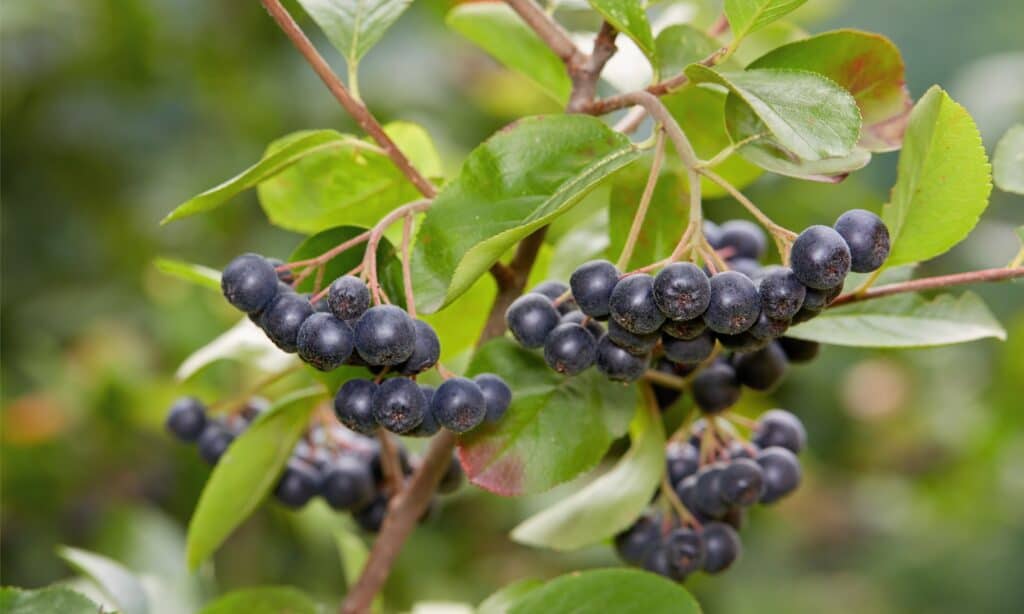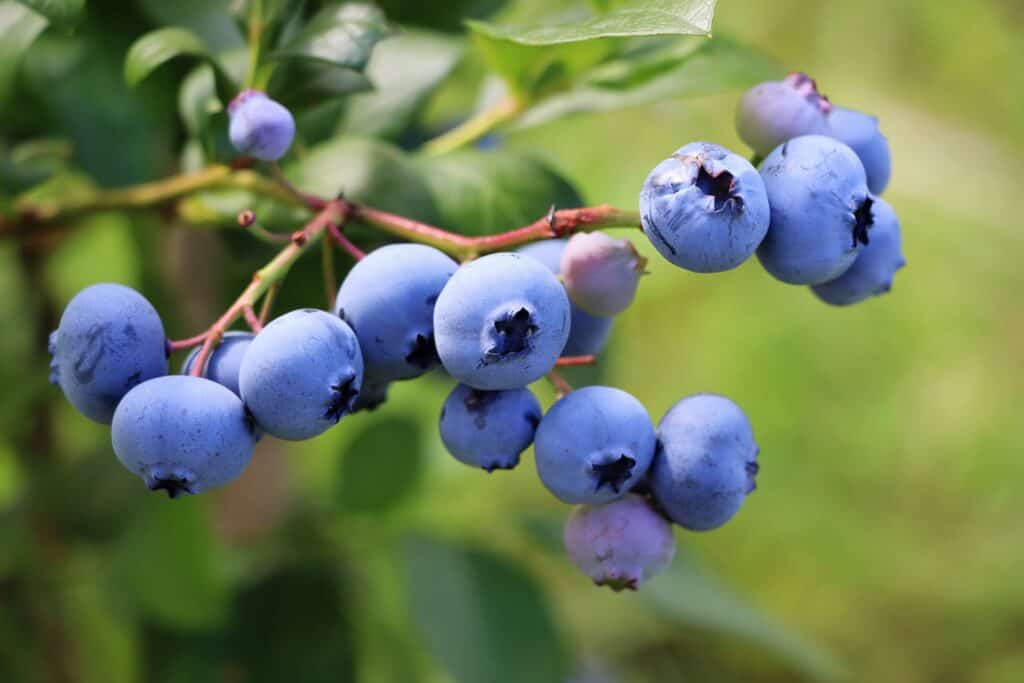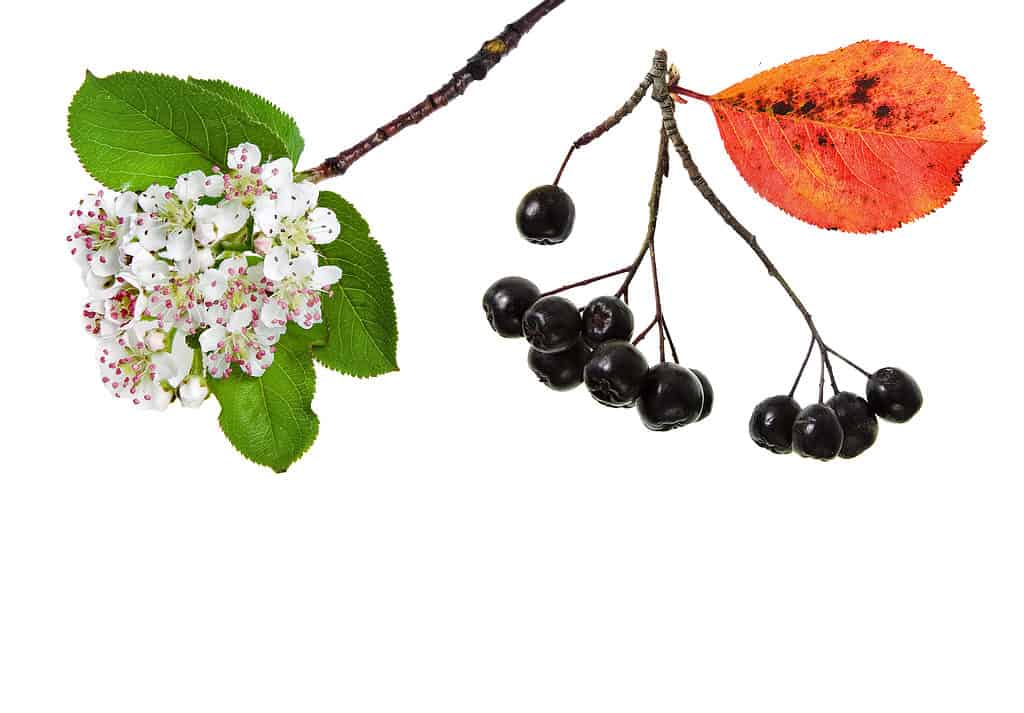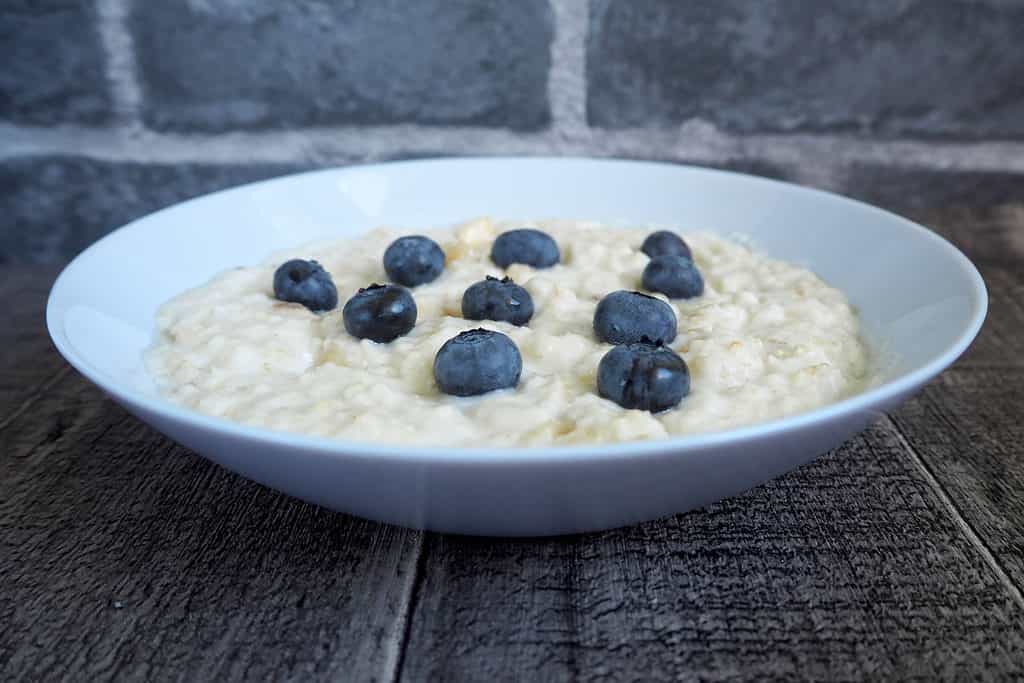In the case of Aronia berry vs. blueberry, the jury is deadlocked. While Aronia berries are guilty of being packed with more nutrition, the blueberry is guilty of being more flavorful. Though Aronia berries have a distinct advantage over blueberries when it comes to their healthful properties, both of these berries are considered superfoods. Blueberries, however, are considered more palatable, thanks to their sweeter flavor.
Keep reading to learn about the origins, physical characteristics, health benefits, and culinary uses of these two plants.
Comparing Aronia Berry to Blueberry:
| Aronia Berry | Blueberry | |
|---|---|---|
| Genus | Aronia | Vaccinium |
| Description | branching shrub with 2-3 inch glossy green ovate leaves that can grow to six feet; produces clusters of round dark-purple to black fruit in late summer. | prostrate shrub with green 1 inch long ovate leaves that can reach 13 feet in height; produces lavender to deep-blue fruit harvested throughout the summer |
| Uses | Can be eaten raw, but often found in processed foods like jams and jellies; leaves are not edible | A treat eaten raw or as an addition to a variety of foods including smoothies and baked goods; leaves are edible |
| Growing Zones | USDA Zones 3-8 | USDA Zones 3-8 |
Origins
Aronia Berry
Aronia Berry (Aronia melanocarpa) is native to North America. Humans have been using aronia berries in a variety of ways for thousands of years. The Potawatomi, Native Americans who lived in the Western Great Lakes region and the Great Plains, brewed a tea of the Aronia plant’s branches and leaves, providing relief and healing from fevers and colds. Using the juice of the Aronia, the Potawatomi created dye, war paint, and a tincture for treating cuts and bruises.
Aronia plants were endemic to North America, until being introduced to Poland in the late 1970s. In the intervening years, Poland has become the world’s leading producer of Aronia berries. Poland exports 30-40 metric tons of Aronia berries annually. Poland is responsible for 90 percent of aronia berry sales globally. South Korea, where Aronia berries are wildly popular, receives the majority of Poland’s yield. Aronia berries are also grown in Scandinavia, Russia, and Canada. Thanks to their superfood status, Aronia berries are gaining popularity in the United States. Iowa and Nebraska, in the Midwest, are super producers of this superfood.

Aronia berries were only grown in North America, untii the 1970s when they introduced introduced to Poland.
©iStock.com/gojak
Blueberry
Blueberries (Vaccinium corymbosum), like Aronia berries, are indigenous to North America. However they are also native to a variety of other locations across the globe. Blueberries have been used for medicinal purposes and as a food source for thousands of years. The Algonquin people, native to the area presently called Eastern Canada, used the leaves and stems of the blueberry plant to treat colic in infants and the roots of the plant to induce labor. These indigenous people also gathered blueberries that they would dry, to keep in stores to eat throughout the winter.
It wasn’t until the early 20th century, however, that blueberries were cultivated for mass consumption in the United States. And while Peru is currently the leading producer of blueberries worldwide, the U.S. is consistently ranked among the top 10. The U.S. also ranks as one of the highest importers of blueberries in the world! Maine produces 99 per cent of the country’s wild blueberries. While across the country, Washington State is the number grower of cultivated blueberries in the U.S.

Blueberries are grown and enjoyed around the world.
©vaivirga/Shutterstock.com
Aronia Berry vs. Blueberry: Physical Characteristics
Aronia berries grow on branching shrubs practically anywhere. Growing indigenously from Newfoundland in Canada to the Gulf Coast of the United States, these plants can be identified by their shiny green oval-shaped leaves that appear in early spring, followed by clusters of 5-6 white flowers with five petals each. From later summer to early early fall clusters of deep-purple-to-black fruit are visible on woody stems. In the fall, the Aronia plant’s 2-3 inch long leaves turn red in a showy display before falling to the ground.

A spring brach of Aronia, frame left, and a fall specimen, frame right.
©Madlen/Shutterstock.com
Aronia berry is a hardy plant that will tolerate a variety of growing conditions. These plants thrive in full sun to partial shade, and soil that is dry and sandy to absolutely boggy. Aronia shrubs are disease and pest resistant for the most part, requiring little care.
Blueberry plants can be identified by the ovate green leaves that first appear in early spring when the temperature remains consistently above 45 degrees Fahrenheit. Once the leaves are visible, it’s not long before the plant flowers and fruit begins to appear. Blueberries have a longer fruiting season than Aronias. Blueberries can be harvested as early as March ( Florida, U.S.) and as late as the end of September (Maine, U.S.). When fall approaches, blueberry leaves turn from green to red before dropping off the plant in winter.

Blueberry leaves turn from green to red before dropping off the plant in winter.
©Jackie Tweddle/Shutterstock.com
Blueberries are a little more particular when it comes to habitat. They best in full sun and acidic soil that is kept evenly moist, neither too dry nor too wet. Blueberries are prone to a variety pests and diseases. From aphids and fruit worms to deer and birds, home gardeners must be vigilant when caring for these plants. Blueberries are also susceptible to conditions such as stem blight and stem canker, both of which are caused by fungi.
Aronia Berry vs. Blueberry: Health Benefits
Cultivation and commercialization of the blueberry in North America shattered any chance that the aronia berry may have had at becoming a staple of the American diet. An unfortunate turn of events not only for the Aronia berry, but for the American diet as well.
As it turns out, Aronia berries are vastly superior to blueberries in terms of nutritional value. These little berries are nutrient rich with vitamins and beneficial antioxidants. One ounce of Aronia berries, which is about about 18 berries, provides theraputic doses of vitamin C, B complex vitamins, potassium, calcium, magnesium, iron, and zinc.

Aronia berries are nutrient rich with vitamins and beneficial antioxidants.
©LianeM/Shutterstock.com
Aronia berries also contain a substantial amount of tannins, which are what gives the fruit its dark color. It’s the tannins that make this fruit super! Scientists are studying the numerous ways the tannins in Aronia berries affect health, and are determining that beyond their anti-inflammatory properties, there little wonders may improve cardiovascular health, and prevent certain cancers, including colon cancer and breast cancer. Tannins also lower blood pressure and bad cholesterol, and may even ward off diabetes.
Though Blueberries have many of the same health benefits and nutritional properties as Aronia berries, they have them in substantially lower amounts. Blueberries are rich in vitamins C and K and the minerals manganese and copper.

Blueberries are rich in vitamins C and K and the minerals manganese and copper.
©NataliSel/Shutterstock.com
However, it’s the dose of tannins the Aronia berry provides that really separates these two superfoods. According to the USDA Oxygen Radical Absorbance Capacity Scale, Aronia berries have 400 per cent more tannins than blueberries! It’s information like this that has put the Aronia berry back on the map in the USA.
Aronia Berry vs. Blueberry: Culinary Uses
Aronia berries definitely have the edge when it comes to nutritional value, however, in the kitchen the blueberry reigns supreme.
The mega-dose of tannins that Aronia berries provide renders them less palatable than blueberries. The organic compounds found in tannins are bitter and astringent. Astringents temporarily shrink/tighten body tissues, which is why highly astringent foods have the tendency to make one’s mouth pucker, and Aronia berries eaten raw are absolutely mouth-puckering.
That’s why Aronia berries are more prevalent in processed foods like jams, jellies, and juices. Adding sugar to aronia berries makes them delicious. Beware! The uncooked leaves of the Aronia plant are NOT edible. They contain cyanide, as do the raw seeds of the fruit.

Aronia berries are more prevalent in processed foods like jams, jellies, and juices.
©Geshas/Shutterstock.com
Blueberry leaves are edible, however. Blueberry leaves have more nutrients that the berries themselves! A tea made from blueberry leaves can provide relief from any number of health conditions. Research has discovered that drinking blueberry tea regularly will decrease inflammation, lower triglycerides and blood pressure, and lessen the effects of arthritis and allergies.

From yogurt to muffins, blueberries add flavor and nutrition to the foods we love.
©Chepko Danil Vitalevich/Shutterstock.com
Blueberries are a delicious addition to an amazing array of foods. From yogurt to muffins, blueberries add flavor and nutrition to the foods we love. Blueberries are also a healthful snack on their own, and will not make one’s mouth pucker and tighten!
It’s easy to see why, in the case of the Aronia berry vs. the blueberry the jury was deadlocked. Both berries have impressive attributes. Aronia berries are definitely guilty of being the more healthful fruit, while blueberries are a guilty pleasure when eaten by the handful.
Up Next:
The photo featured at the top of this post is © LianeM/Shutterstock.com
Sources
- medicinenet.com, Available here: https://www.medicinenet.com/are_aronia_berries_similar_to_blueberries/article.htm
- thespruceeats.com/, Available here: https://www.thespruceeats.com/what-are-aronia-berries-4778277
- treetime.ca, Available here: https://treetime.ca/compare.php?pcids=220-288
- insidehook.com, Available here: https://www.insidehook.com/article/health-and-fitness/what-are-aronia-berries
- uniquetme.com, Available here: https://uniquetime.com/what-is-aroniaberry/
- typworld.com, Available here: https://tvpworld.com/37776776/agricultural-asset-polish-chokeberry-conquers-the-world
- cbc.ca, Available here: https://www.cbc.ca/news/canada/newfoundland-labrador/blueberry-leaves-snack-mun-pharmacy-student-1.3504189
Thank you for reading! Have some feedback for us? Contact the AZ Animals editorial team.






